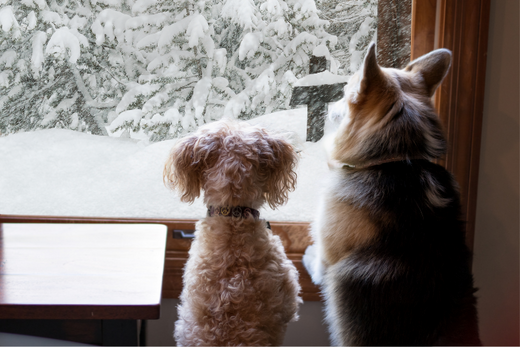Preparing Your Pet For a Snowstorm

For some, the alert of a snow day brings joy and excitement. For others, it’s a nuisance, a danger, and can interfere with your pet’s schedule. Despite how complicated it might be to prepare for a snowstorm, being proactive is worth the work – especially when you have pets.
Unlike in some other emergency situations, you will most likely be hunkering down at home when you learn a snowstorm is incoming. But even though you won’t need an evacuation bag, it’s important to have everything you’ll need set aside at home. Below, we’ll cover a few tips for staying safe and preparing your pet for a snowstorm.
Preparing Ahead of Time For Snow
Some elements of snowstorms can be unpredictable. That said, early precautions can reduce the chances of running out of supplies, feeling stressed, or putting you or your pet in danger.
Much like preparing your human family for a snowstorm, preparing your pet means having everything they may need organized and accessible.
Let’s cover the basic elements of a snowstorm pet plan.
Emergency Supplies
Set aside anything your pet might need if you were to be stranded at home, including:
- Your pet’s medications (at least a week’s supply)
- Food & Bowls (at least a week’s supply)
- Water (have bottled water on hand if needed)
- Litter Supplies
- Pee Pads
- Lots of warm bedding
- Leashes & Harnesses
- Identification & Photos (in case your pet goes missing)
- First aid supplies that are appropriate for pets
- Calming supplements such as CBD
- Boredom-busting activities and games for indoors
Health Precautions
Before the arrival of a snowstorm, make sure your pet has seen their veterinarian. A check-up can ensure the animal is in ideal health and has current vaccines and a microchip. This way, if you are unable to leave the house for days or a week, you will know your pet’s current conditions. Also make sure you have backup medication if you for some reason get stuck at home for a week or more.
Remaining at Home
Be sure to prepare your home. Check to be sure your smoke and carbon monoxide detectors are working. If you have a fireplace, make sure it is clean and pet-safe (there should be a screen in place to keep pets way). Make sure you have all supplies you will need, blankets, and a crate in the warmest room of the house. If you need to, run out to the store before the storm hits to purchase extra pet food or other supplies you may need.

During the Storm
When a snowstorm approaches your area, bring your pets inside and secure them in a safe area or a crate. Some snowstorms can be loud and frightening. Keep your pet relaxed and calm.
Listen to your local weather service for announcements and monitor your pet as the storm passes.
Do not take your pet outside in dangerous or extreme weather. If your pet needs to relieve themselves, use a garage or a potty pad/litter area indoors. If the snowstorm isn’t extreme, take your pet outside for very quick breaks. Things can turn dangerous or extremely cold quickly.
Staying Warm
Losing power during the winter can be dangerous. If you lose power and are unable to leave or find a backup source of heat, you will want to have a plan for keeping your pet and yourself warm.
- Stay indoors as much as possible
- Limit yourselves to the warmest room (and close off rooms that aren’t in use).
- Cover your dog’s crate in an insulating towel or blanket and add additional bedding to the inside of the crate.
- Make sure you home is insulated before disaster strikes.
- Make sure you and your pet stay full, hydrated, and rested.
Leaving Home
Do your best not to leave home during or immediately after the storm. Remember that road conditions can remain dangerous even days after it snows. If you need to leave your house, ask for help if you need it. If you’re unable to shovel your driveway, call a neighbor or local service. If you have a pet emergency, call your veterinarian before driving to the vet.
Keeping Busy
Your pet still needs some mental and physical exercise, even if you can’t go outside. If you don’t have power and are struggling to stay warm, preserving energy is always the most important. However, if you have your and your pet’s basic needs met, you may want to play some indoor games to avoid cabin fever. Consider playing fetch in the hallway, practicing obedience skills, or setting up an interactive toy or snuffle mat.
After the Storm
After the snow has passed, check your pet’s paws and nose for frostbite, sensitivity, or dryness. Consider applying a topical ointment.
It’s also important to keep an eye out for strange behavior and contact a veterinarian if you’re concerned about how your pet is acting.
Check your yard and surrounding area for potential dangers as well. After snow melts away, there may be additional dangers underneath, such as fallen branches or other objects. Sidewalks and streets may still be covered in salt, which is dangerous for pets.
Keep in mind, if the snowstorm was stressful and frightening for you, it was probably stressful for your pet as well. Do your best to provide support and security and help them overcome any lingering fears.


